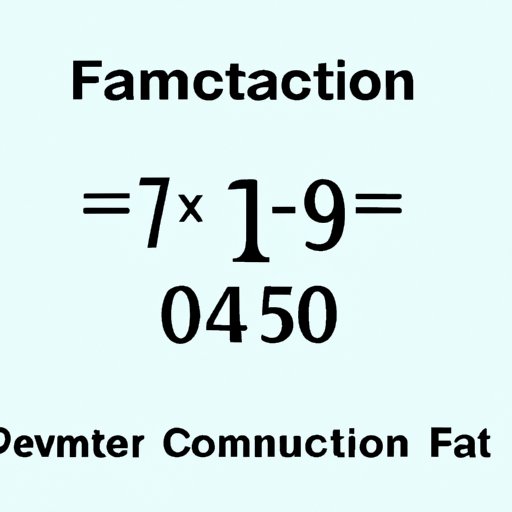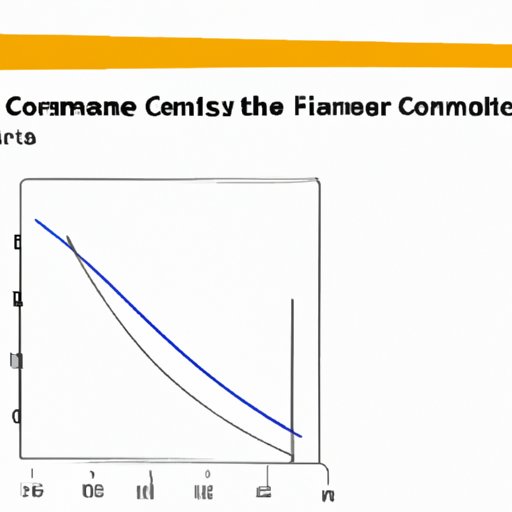
I. Introduction
If you’re looking to improve your math skills, one concept you simply cannot overlook is the greatest common factor. Known in math circles as GCF, this fundamental concept is used to simplify fractions, factor polynomials, and even solve problems in fields as diverse as engineering and cryptography. But what exactly is GCF and how can you find it easily and efficiently? This article will walk you through everything you need to know, from the basic principles to clever tips and tricks that will quickly bring your GCF-finding abilities to the next level.
II. 5 Simple Steps to Finding the Greatest Common Factor
To find the GCF, you’ll want to start with prime factorization. Here’s how to do it:
- Write each number in its prime factorization form. For example, 30 becomes 2 x 3 x 5.
- List each factor that is common to both numbers. For example, if you’re trying to find the GCF of 30 and 40, both numbers have a factor of 2. These common factors are the ones you’ll want to focus on.
- Multiply all of the common factors together. For the example above, the common factor is 2, so you would multiply 2 x 1, which equals 2.
- Continue to check for additional factors that are common to both numbers and multiply them with the existing product. For example, if you’re finding the GCF of 18 and 24, you would multiply the existing product (2) by the common factor of 3, resulting in a GCF of 6.
- When there are no more common factors to multiply, you have found the GCF.
To make things even clearer, let’s take a look at an example:
Find the greatest common factor of 60 and 84.
- 60 = 2 x 2 x 3 x 5
- 84 = 2 x 2 x 3 x 7
Now we can see that the common factors are 2 x 2 x 3, which equals 12. Therefore, the GCF of 60 and 84 is 12.
III. Mastering the Art of Greatest Common Factor: Tips and Tricks
Once you have the basics down, there are many tips and tricks you can use to make finding the GCF even easier. Here are a few:
- Start by finding the factors: Before you start looking for the GCF, take some time to find the factors of each number. This can help you quickly identify common factors without needing to list all prime factors.
- Keep it simple: If the numbers you’re working with have a common factor of 1, then the GCF is automatically 1.
- Watch for patterns: If you’re working with multiple numbers, try to look for patterns. For example, if all the numbers are even, then 2 is a common factor. If all the numbers are odd, then the GCF is automatically 1.
- Use divisibility rules: There are many rules you can use to determine whether a number is divisible by another number. For example, a number is divisible by 3 if the sum of its digits is divisible by 3.
IV. Breaking Down the Greatest Common Factor: A Comprehensive Guide
There are a few different methods for finding the GCF, each with its own pros and cons. Here’s a breakdown of the most common methods:
Euclidean Algorithm
This is a popular algorithm that can be used to find the GCF of two numbers. To use it, simply divide the larger number by the smaller number. Keep track of the remainder, then divide the smaller number by the remainder. Repeat until the remainder is 0. The last non-zero remainder is the GCF.
Factor Tree Method
This method is similar to prime factorization, but instead of writing out all the prime factors, you create a factor tree. To do this, you start by writing the two numbers you want to find the GCF of at the top of a piece of paper. Then, find a factor that both numbers share, and write it down underneath the two numbers. Keep repeating this process until you have only prime numbers left. The GCF is the product of all these prime factors.
Division Method
This method involves dividing the larger number by the smaller number. If there is no remainder, the smaller number is the GCF. If there is a remainder, divide the smaller number by the remainder. Continue until you have no remainder. The last non-zero remainder is the GCF.
V. Why Finding the Greatest Common Factor is Important and How to Do It
While it might seem like the concept of the GCF is only important in a math classroom, the truth is that knowing how to find the GCF can be incredibly useful in real life.
For example, engineers use GCF to determine the smallest common factor for gears, wheels, and other mechanical components. In physics, GCF plays a role in wave calculations and other applications. Cryptography relies heavily on GCF calculations for secure coding.
Here’s an example of how GCF is used in the engineering field:
An engineer has two gears with 36 and 48 teeth. What is the smallest number of teeth that both gears can have?
To find the answer, we need to find the GCF of 36 and 48. Using the prime factorization method, we can see that the GCF is 2 x 2 x 3 = 12.
VI. Solve Math Problems Faster: How to Find the Greatest Common Factor Quickly
If you’re short on time or don’t want to rely on prime factorization every time you need to find the GCF, there are a few other methods you can use:
Listing Method
List all the factors of each number, then identify the largest factor that both numbers share. This is the GCF.
Repeated Division Method
Divide the larger number by the smaller number. If there is no remainder, the smaller number is the GCF. If there is a remainder, divide the smaller number by the remainder. Continue until you find the GCF.
Using a Calculator
Many calculators have a GCF function that can quickly find the GCF of two numbers.

VII. Visualizing the Greatest Common Factor: Using Diagrams and Charts
If you’re a visual learner, using diagrams and charts can help you easily find the GCF. Here are a few options:
Venn Diagram
A Venn diagram is a visual representation of two sets. In the case of GCF, you can create a Venn diagram that shows the factors of each number. The common factors that overlap in the middle are the GCF.
Factor Grid
A factor grid is a table that shows the factors of each number. To use this method, make a grid with the two numbers at the top and the factors listed below. Compare the two lists of factors and identify the largest one that both numbers share. This is the GCF.
VIII. Common Pitfalls to Avoid When Finding the Greatest Common Factor
Even the best mathematicians make mistakes. To avoid these common pitfalls, keep the following tips in mind:
- Make sure you’re not dealing with decimals: Greatest common factor is used only with whole numbers, not decimals. Be sure to convert any decimals to whole numbers before you begin.
- Don’t forget about the factor 1: When listing all the factors, be sure to include the number 1.
- Check for common mistakes: Common mistakes include misidentifying prime numbers, failing to list all the factors, and misinterpreting the question.
- Check your work: Re-checking your work can help you catch errors before they become big problems.
IX. Conclusion
By now, you should have a solid understanding of the greatest common factor and how to find it using a variety of different methods. Whether you’re working on a math problem or trying to find the right gears for your latest engineering project, the ability to find the GCF can be incredibly useful.




